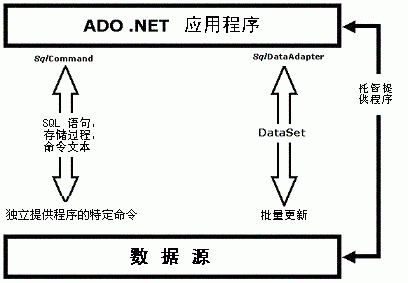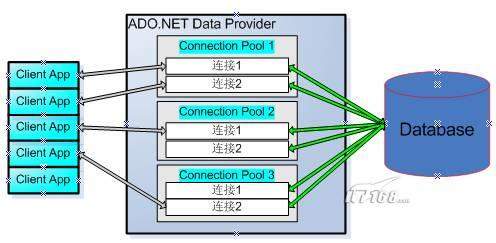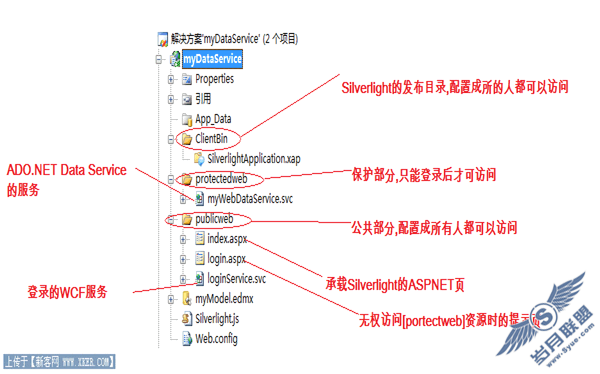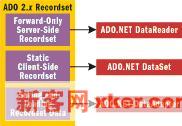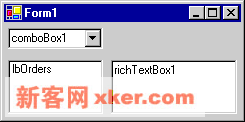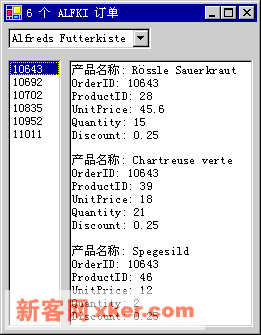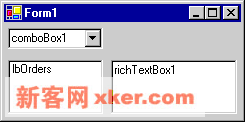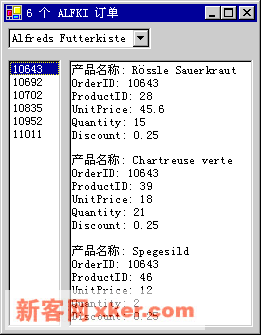总结:ADO.NET在开发中的部分使用方法和技巧(2)
如何使用 SqlDataReader 来检索单个行
可以使用 SqlDataReader 对象来检索单个行,尤其是可以从返回的数据流中检索需要的列值。以下代码片段对此进行了说明。
void GetProductDetailsUsingReader( int ProductID, out string ProductName, out decimal UnitPrice ){ using( SqlConnection conn = new SqlConnection( "server=(local);Integrated Security=SSPI;database=Northwind") ) { // Set up the command object used to execute the stored proc SqlCommand cmd = new SqlCommand( "DATGetProductDetailsReader", conn ); cmd.CommandType = CommandType.StoredProcedure; // Establish stored proc parameters. // @ProductID int INPUT SqlParameter paramProdID = cmd.Parameters.Add( "@ProductID", ProductID ); paramProdID.Direction = ParameterDirection.Input; conn.Open(); using( SqlDataReader reader = cmd.ExecuteReader() ) { if( reader.Read() ) // Advance to the one and only row { // Return output parameters from returned data stream ProductName = reader.GetString(0); UnitPrice = reader.GetDecimal(1); } } }}使用 SqlDataReader 对象来返回单个行
1.
建立 SqlCommand 对象。
2.
打开连接。
3.
调用 SqlDataReader 对象的 ExecuteReader 方法。
4.
通过 SqlDataReader 对象的类型化访问器方法(在这里,为 GetString 和 GetDecimal)来检索输出参数。
上述代码片段调用了以下存储过程。
CREATE PROCEDURE DATGetProductDetailsReader@ProductID intASSELECT ProductName, UnitPrice FROM ProductsWHERE ProductID = @ProductIDGO
如何使用 ExecuteScalar 来检索单个项
ExecuteScalar 方法专门适用于仅返回单个值的查询。如果查询返回多个列和/或行,ExecuteScalar 将只返回第一行的第一列。
以下代码说明了如何查找与特定产品 ID 相对应的产品名称:
void GetProductNameExecuteScalar( int ProductID, out string ProductName ){ using( SqlConnection conn = new SqlConnection( "server=(local);Integrated Security=SSPI;database=northwind") ) { SqlCommand cmd = new SqlCommand("LookupProductNameScalar", conn ); cmd.CommandType = CommandType.StoredProcedure; cmd.Parameters.Add("@ProductID", ProductID ); conn.Open(); ProductName = (string)cmd.ExecuteScalar(); }}使用 ExecuteScalar 来检索单个项
1.
建立一个 SqlCommand 对象来调用存储过程。
2.
打开连接。
3.
调用 ExecuteScalar 方法。注意,该方法返回一个对象类型。它包含检索到的第一列的值,并且必须转化为适当的类型。
4.
关闭连接。
上述代码使用了以下存储过程:
CREATE PROCEDURE LookupProductNameScalar@ProductID intASSELECT TOP 1 ProductNameFROM ProductsWHERE ProductID = @ProductIDGO
如何使用存储过程输出或返回参数来检索单个项
可以使用存储过程输出或返回参数来查找单个值。以下代码阐明了输出参数的用法:
void GetProductNameUsingSPOutput( int ProductID, out string ProductName ){ using( SqlConnection conn = new SqlConnection( "server=(local);Integrated Security=SSPI;database=northwind") ) { SqlCommand cmd = new SqlCommand("LookupProductNameSPOutput", conn ); cmd.CommandType = CommandType.StoredProcedure; SqlParameter paramProdID = cmd.Parameters.Add("@ProductID", ProductID ); ParamProdID.Direction = ParameterDirection.Input; SqlParameter paramPN = cmd.Parameters.Add("@ProductName", SqlDbType.VarChar, 40 ); paramPN.Direction = ParameterDirection.Output; conn.Open(); cmd.ExecuteNonQuery(); ProductName = paramPN.Value.ToString(); }}使用存储过程输出参数来检索单个值
1.
建立一个 SqlCommand 对象来调用存储过程。
2.
通过将 SqlParameters 添加到 SqlCommand 的 Parameters 集合中,设置任何输入参数和单个输出参数。
3.
打开连接。
4.
调用 SqlCommand 对象的 ExecuteNonQuery 方法。
5.
关闭连接。
6.
通过使用输出 SqlParameter 的 Value 属性来检索输出值。
上述代码使用了以下存储过程。
CREATE PROCEDURE LookupProductNameSPOutput @ProductID int,@ProductName nvarchar(40) OUTPUTASSELECT @ProductName = ProductNameFROM ProductsWHERE ProductID = @ProductIDGO
以下代码阐明了如何使用返回值来指明是否存在特定行。从编码角度来看,这类似于使用存储过程输出参数,不同之处在于必须将 SqlParameter 方向显式设置为 ParameterDirection.ReturnValue。
bool CheckProduct( int ProductID ){ using( SqlConnection conn = new SqlConnection( "server=(local);Integrated Security=SSPI;database=northwind") ) { SqlCommand cmd = new SqlCommand("CheckProductSP", conn ); cmd.CommandType = CommandType.StoredProcedure; cmd.Parameters.Add("@ProductID", ProductID ); SqlParameter paramRet = cmd.Parameters.Add("@ProductExists", SqlDbType.Int ); paramRet.Direction = ParameterDirection.ReturnValue; conn.Open(); cmd.ExecuteNonQuery(); } return (int)paramRet.Value == 1;}通过使用存储过程返回值来检查是否存在特定行
1.
建立一个 SqlCommand 对象来调用存储过程。
2.
设置一个输入参数,该参数含有要访问的行的主键值。
3.
设置单个返回值参数。将一个 SqlParameter 对象添加到 SqlCommand 的 Parameters 集合中,并将其方向设置为 ParameterDirection.ReturnValue。
4.
打开连接。
5.
调用 SqlCommand 对象的 ExecuteNonQuery 方法。
6.
关闭连接。
7.
通过使用返回值 SqlParameter 的 Value 属性来检索返回值。
上述代码使用了以下存储过程。
CREATE PROCEDURE CheckProductSP @ProductID intASIF EXISTS( SELECT ProductID FROM Products WHERE ProductID = @ProductID ) return 1ELSE return 0GO
如何使用 SqlDataReader 来检索单个项
可以使用 SqlDataReader 对象并通过调用命令对象的 ExecuteReader 方法来获取单个输出值。这要求编写稍微多一点的代码,因为必须调用 SqlDataReader Read 方法,然后通过该读取器的访问器方法之一来检索需要的值。以下代码阐明了 SqlDataReader 对象的用法。
bool CheckProductWithReader( int ProductID ){ using( SqlConnection conn = new SqlConnection( "server=(local);Integrated Security=SSPI;database=northwind") ) { SqlCommand cmd = new SqlCommand("CheckProductExistsWithCount", conn ); cmd.CommandType = CommandType.StoredProcedure; cmd.Parameters.Add("@ProductID", ProductID ); cmd.Parameters["@ProductID"].Direction = ParameterDirection.Input; conn.Open(); using( SqlDataReader reader = cmd.ExecuteReader( CommandBehavior.SingleResult ) ) { if( reader.Read() ) { return (reader.GetInt32(0) > 0); } return false; }}上述代码采用了以下存储过程。
CREATE PROCEDURE CheckProductExistsWithCount @ProductID intASSELECT COUNT(*) FROM ProductsWHERE ProductID = @ProductIDGO
如何编写 ADO.NET 手动事务处理代码
以下代码显示了如何充分利用 SQL Server .NET 数据提供程序所提供的事务处理支持,通过事务来保护资金转帐操作。该操作在同一数据库中的两个帐户之间转移资金。
public void TransferMoney( string toAccount, string fromAccount, decimal amount ){ using ( SqlConnection conn = new SqlConnection( "server=(local);Integrated Security=SSPI;database=SimpleBank" ) ) { SqlCommand cmdCredit = new SqlCommand("Credit", conn ); cmdCredit.CommandType = CommandType.StoredProcedure; cmdCredit.Parameters.Add( new SqlParameter("@AccountNo", toAccount) ); cmdCredit.Parameters.Add( new SqlParameter("@Amount", amount )); SqlCommand cmdDebit = new SqlCommand("Debit", conn ); cmdDebit.CommandType = CommandType.StoredProcedure; cmdDebit.Parameters.Add( new SqlParameter("@AccountNo", fromAccount) ); cmdDebit.Parameters.Add( new SqlParameter("@Amount", amount )); conn.Open(); // Start a new transaction using ( SqlTransaction trans = conn.BeginTransaction() ) { // Associate the two command objects with the same transaction cmdCredit.Transaction = trans; cmdDebit.Transaction = trans; try { cmdCredit.ExecuteNonQuery(); cmdDebit.ExecuteNonQuery(); // Both commands (credit and debit) were successful trans.Commit(); } catch( Exception ex ) { // transaction failed trans.Rollback(); // log exception details . . . throw ex; } } }}如何使用 Transact-SQL 执行事务处理
以下存储过程阐明了如何在 Transact-SQL 存储过程内部执行事务性资金转帐操作。
CREATE PROCEDURE MoneyTransfer@FromAccount char(20),@ToAccount char(20),@Amount moneyASBEGIN TRANSACTION-- PERFORM DEBIT OPERATIONUPDATE AccountsSET Balance = Balance - @AmountWHERE AccountNumber = @FromAccountIF @@RowCount = 0BEGIN RAISERROR('Invalid From Account Number', 11, 1) GOTO ABORTENDDECLARE @Balance moneySELECT @Balance = Balance FROM ACCOUNTSWHERE AccountNumber = @FromAccountIF @BALANCE < 0BEGIN RAISERROR('Insufficient funds', 11, 1) GOTO ABORTEND-- PERFORM CREDIT OPERATIONUPDATE Accounts SET Balance = Balance + @Amount WHERE AccountNumber = @ToAccountIF @@RowCount = 0BEGIN RAISERROR('Invalid To Account Number', 11, 1) GOTO ABORTENDCOMMIT TRANSACTIONRETURN 0ABORT: ROLLBACK TRANSACTIONGO该存储过程使用 BEGIN TRANSACTION、COMMIT TRANSACTION 和 ROLLBACK TRANSACTION 语句来手动控制该事务。
如何编写事务性 .NET 类
以下示例代码显示了三个服务性 .NET 托管类,这些类经过配置以执行自动事务处理。每个类都使用 Transaction 属性进行了批注,该属性的值确定是否应该启动新的事务流,或者该对象是否应该共享其直接调用方的事务流。这些组件协同工作来执行银行资金转帐任务。Transfer 类被使用 RequiresNew 事务属性进行了配置,而 Debit 和 Credit 被使用 Required 进行了配置。结果,所有这三个对象在运行时都将共享同一事务。
using System;using System.EnterpriseServices;[Transaction(TransactionOption.RequiresNew)]public class Transfer : ServicedComponent{ [AutoComplete] public void Transfer( string toAccount, string fromAccount, decimal amount ) { try { // Perform the debit operation Debit debit = new Debit(); debit.DebitAccount( fromAccount, amount ); // Perform the credit operation Credit credit = new Credit(); credit.CreditAccount( toAccount, amount ); } catch( SqlException sqlex ) { // Handle and log exception details // Wrap and propagate the exception throw new TransferException( "Transfer Failure", sqlex ); } }}[Transaction(TransactionOption.Required)]public class Credit : ServicedComponent{ [AutoComplete] public void CreditAccount( string account, decimal amount ) { try { using( SqlConnection conn = new SqlConnection( "Server=(local); Integrated Security=SSPI"; database="SimpleBank") ) { SqlCommand cmd = new SqlCommand("Credit", conn ); cmd.CommandType = CommandType.StoredProcedure; cmd.Parameters.Add( new SqlParameter("@AccountNo", account) ); cmd.Parameters.Add( new SqlParameter("@Amount", amount )); conn.Open(); cmd.ExecuteNonQuery(); } } }catch( SqlException sqlex ){ // Log exception details here throw; // Propagate exception }}[Transaction(TransactionOption.Required)]public class Debit : ServicedComponent{ public void DebitAccount( string account, decimal amount ) { try { using( SqlConnection conn = new SqlConnection( "Server=(local); Integrated Security=SSPI"; database="SimpleBank") ) { SqlCommand cmd = new SqlCommand("Debit", conn ); cmd.CommandType = CommandType.StoredProcedure; cmd.Parameters.Add( new SqlParameter("@AccountNo", account) ); cmd.Parameters.Add( new SqlParameter("@Amount", amount )); conn.Open(); cmd.ExecuteNonQuery(); } } catch (SqlException sqlex) { // Log exception details here throw; // Propagate exception back to caller } }}
